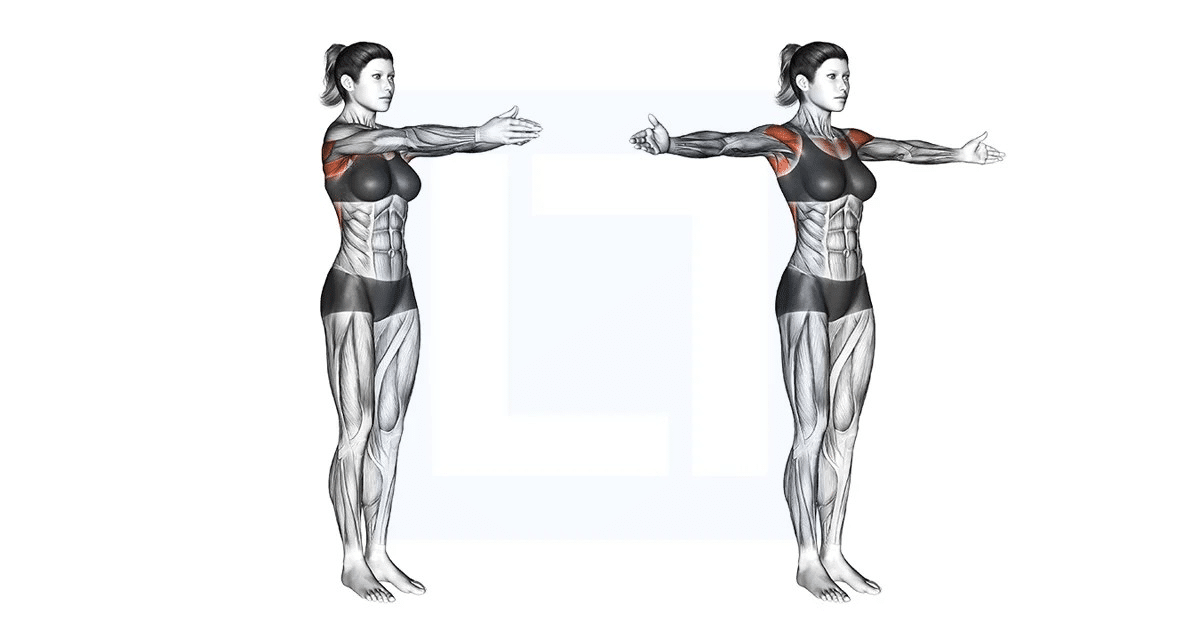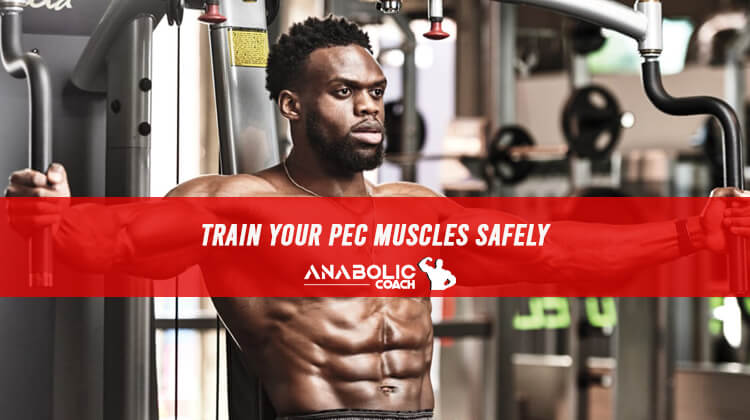If you want a strong and well chiseled upper body, you should know that you have to pay attention to training your pectoral or pec muscles.
By regularly training the upper part of your body, you will be able to lift heavy which then stimulates muscle mass growth.
This is where this article can prove to be most useful. We reveal how you can work your chest muscles hard, but in a safe way. You will learn how to avoid injuries during training as well as what you should do to recover fast from muscle-related injuries.
5 Pec Muscle Building Workouts for You
Your pectoral muscles are primarily made up of pectoralis minor and pectoralis major muscle groups. These pec muscle groups are the reason why you are able to perform compound movements, such as; the rotation of your arms, pulling and pushing movements.
What’s more, your pectoralis minor and pectoralis major muscles are compartmentalized into the lower, middle and upper regions. You can target each and all three of the regions of your pectoralis minor and pectoralis major muscles when you engage in a variety of chest muscle exercises.
Some of the best pec exercises you can perform at home or at your local gym include the following:
#1. Push-Ups
To successfully perform a push-up, you need to feel your chest muscles stretching as you lower down your body to the floor. When you attempt to push your body back to your starting position, your pec muscles will contract.
This is necessary as chest muscles are partly responsible for lifting your entire body weight during a push-up exercise. As you perform a push-up exercise, you will train the lower and middle regions of your pectoral muscle groups.
In effect, push-ups are great for targeting not just your pectoralis minor and pectoralis major (lower and middle regions) muscles, but they are also great for stabilizing your core, training your anterior deltoids or front shoulder muscles, and triceps.
You may be interested to know that there are a variety of push-ups that you can try out with each effectively training your pec muscles.
Some push-up variations you can attempt are incline push-ups, decline push-ups, and wide push-ups.
With incline push-ups, you will train the lower regions of your pec muscles. To do this exercise, you need to push-up with your hands placed on a high surface area like a table or bench.
On the other hand, decline push-ups require you to elevate your feet whilst executing the push-up. Decline push-ups will help train the upper region of your pec muscles.
When it comes to performing a wide push-up, you need to spread out your hands at a wider stance before lowering your body as usual. This variation of push-up will train the lateral fibers of your pectoralis major muscles or your outer chest.
#2. Dumbbell Chest Press
To effectively execute the dumbbell chest press, you contract your pecs to push the weight of the dumbbells away from your body before they are pressed upwards.
As you press the dumbbells upwards, the range of motion generated will activate the muscle fibers of your pecs, targeting the middle region of your pec muscles in particular.
The advantage of performing this exercise with dumbbells instead of a barbell is that with dumbbells you are able to achieve a much more expansive range of motion to optimize the contraction of your pec muscles while minimizing your risk of both shoulder and chest muscle strains.
In addition to this, the dumbbell chest press will give your chest muscles a much more balanced appearance. Ultimately, this workout will target both the upper and middle regions of your pectoralis major muscles while also training your anterior deltoids and triceps.

#3. Chest Flyes
Chest flyes are one of those chest muscle exercises that will help give your pecs more definition and shape.
With chest flyes your chest muscles are stretched out at the bottom end of the movement while as your hands are brought close together at the top end of the movement, your chest muscles will then contract to target both your inner and outer chest.
You can perform different variations of chest flyes at home or at the gym. If you want to target your upper pecs in particular, you can try out incline dumbbell flyes while resistance band flyes are perfect for anyone that prefers resistance band or bodyweight workouts.
Resistance band flyes are reputed for training the chest muscles with the risk of minimal joint strain.
#4. Incline Bench Press
Perform the incline bench press at an incline angle of between 30 to 45 degrees. This ensures that the load is shifted from your middle chest region to your upper chest region which is significant as the upper chest is often the least developed region in many bodybuilders and athletes.
So if you want more defined and balanced pec muscles, then you should not ignore this pec muscle training routine.
Apart from targeting the upper region of your pectoralis major, the incline bench press exercise will also activate your triceps and anterior deltoids.
#5. Bodyweight or Weighted Dips
As you lean slightly forward during your dips, you will activate your lower chest muscles. Also, note that you can further enhance both your pec muscle activation and overall development the deeper you perform bodyweight or weighted dips.
With dips you will target mainly the lower region of your pectoralis major muscles. This gym or home pec workout will also strengthen and stabilize your core while targeting your anterior deltoids and triceps at the same time.
Like the other pec muscle training workouts mentioned here, dips also come on a number of variations like chest dips and triceps dips.

Pec Injury Prevention and Quick Pec Injury Rehab Tips
While the five (5) pec muscle workouts in this article will help to strengthen chest muscles, you should also be aware that stretching for pec muscles can leave you more susceptible to chest muscle strains and injuries, especially if you do not apply proper form and technique when executing the exercises.
However, the four (4) pec workout tips below will go a long way in helping you to prevent pec injuries.
#1. Don’t Forget to Warm-Up
You should never forget to warm-up before you perform any of the chest exercises mentioned in this guide. You should spend anywhere from 5 to 10 minutes on warm-up routines that target your upper body particularly your arms, shoulders, and chest.
By engaging in a proper warm-up routine, you will improve both mobility and blood flow to your upper body before you commence your pec muscle training sessions.
#2. Maintain a Slow and Steady Progressive Overload
The best way to improve your pec muscles is to begin your pec workout using light weights with more repetitions (reps) then gradually increase lifting weights with a moderate to low rep range depending on the weights.
By applying progressive overload principles to your sessions, you will prevent severe strains to your chest and shoulder ligaments and tendons.
#3. Maintain Perfect Form for Safety and Injury Prevention
You should maintain proper form for safety and injury prevention at all times. To achieve this, you should always concentrate on smooth, controlled, seamless movements devoid of any jerking or bouncing.
By doing so, you will ensure optimal muscle engagement while minimizing joint strains at the same time.
#4. Keep Your Training Sessions Balanced
To avoid having to spend an enormous amount of time on chest injury recovery, you should always keep your training program balanced by including back workouts like lat pulldowns and rows to your training program.
Tips for Quick Chest Injury Recovery
When you need to go into pec injury rehab due to a hapless chest injury, you should never do anything that will compromise your recovery by stressing the root cause of the problem.
To improve your chest injury recovery time, you should do the following:
Apply Ice and Rest Well
You can significantly reduce both the inflammation and pain associated with chest injuries by applying ice to the problem area and resting well. You can apply ice for between 15 and 20 minutes at a time and for as many times as you can in a day.
Engage in Active Recovery
While rest is essential to quick recovery for chest injuries, you should never ignore the importance of active recovery.
You should perform light movements by engaging in light stretching and even resistance band workout to help improve both your blood circulation and mobility. However, always consider doing those workouts that won’t aggravate the problem.

Perform Rehabilitation Workouts
You can build-up your strength by engaging in light workouts like resistance band presses or variations of push-ups. Your rehabilitation workouts should commence in about a couple of weeks or whenever the initial pain caused by your chest injury subsides.
Rev-Up Your Nutrition
Never ignore the importance of nutrition to your recovery. Note that protein is important for promoting muscle repair and recovery.
Therefore, you should make sure that your nutrition is rich in protein with the best sources being lean beef, fish, chicken, eggs, legumes, lentils and other rich plant sources of protein.
In addition to eating protein-packed meals, do not forget to consume those foods that offer anti-inflammatory properties and can help to speed up your recovery. These foods include turmeric powder, fish oil or leafy greens.
Seek Out Professional Assistance
Never leave anything to chance, so if your health should deteriorate, you should pay a visit to your physician for a physical examination and further tests.
However, if you need more information on how to train your pecs in an effective, but safe manner, you can get in touch with our in-house IFBB PRO for free today.
Conclusion
If you want to train your chest muscles in an effective, but safe way, you need to mix things up a bit. Try different chest muscle exercises that will ensure every part of your chest muscles get a proper workout.
What’s more, it is important that you consult with a fitness trainer before you start, especially if you are a newbie. Your training program should be drafted to meet your peculiar muscle building needs and a bodybuilding expert should help in that regard.
Finally, do not forget to take your recovery from chest muscle strains or other more severe injuries seriously. Take time off to get sufficient rest and only do light activation and stretching exercises during your recovery period.


